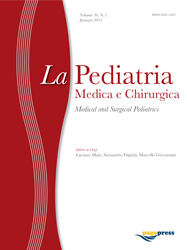Management of parapneumonial pleural empyema in children: a survey of the Italian Society of Infantile Videosurgery (SIVI)
All claims expressed in this article are solely those of the authors and do not necessarily represent those of their affiliated organizations, or those of the publisher, the editors and the reviewers. Any product that may be evaluated in this article or claim that may be made by its manufacturer is not guaranteed or endorsed by the publisher.
Authors
The purpose of this paper was to define the specturm of management for Parapneumonial Pleural Effusion/Pleural Empyema (PE/PPE) in children in Italy. We conducted an online survey, distributed by the SIVI committee to 54 Italian pediatric surgery centers. A total of 23/54 (43%) Italian pediatric surgery centers responded. All responders (100%) required an anteroposterior chest radiograph (CXR) as the first imaging approach to suspect PPE, and chest Ultrasound (US) was routinely used in 96% of centers. A preoperative CT scan was routinely performed in 70% of centers. An etiological diagnosis was obtained in more than 80% of patients in 13% of centers, between 40% and 80% of cases in 61% of centers and in less than 40% of patients in 26% of centers. Empirical antimicrobial therapy with 2 antibiotics is the most commonly used therapeutic scheme (78% of centers) and targeted antibiotic therapy was used in 82% of enrolled centers. The majority of centers (57%) approached advanced stage pleural empyema with pleural drain placement and fibrinolysis (PDF); 26% of centers preferred to execute upfront Video-Assisted Thoracoscopic Debridement (VATD), and in 13% of centers, both fibrinolysis and VATD were used. In all cases (100%), urokinase was the fibrinolytic agent of choice. Broncho-Pleural Fistula (BPF) was treated conservatively with prolonged Pleural Drainage (PD) and antibiotics in 82% of centers, while the remaining 18% proposed early surgical treatment. 82% of centers proposed prolonged antimicrobial therapy for the treatment of Lung Abscess (LA), while 18% of centers preferred to execute upfront ultrasound-guided or thoracoscopic positioning of a pig-tail drain. As expected, we observed a lack of homogeneity in the treatment between the different centers: most of these have a preference for fibrinolysis over the use of primary VATD, with urokinase being the only fibrinolytic agent used in all centers. It would be desirable to involve as many centers as possible for the drafting of shared national guidelines in the treatment of PPE in children in Italy.
How to Cite

This work is licensed under a Creative Commons Attribution-NonCommercial 4.0 International License.






